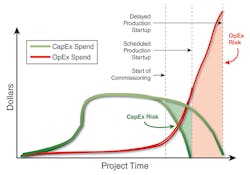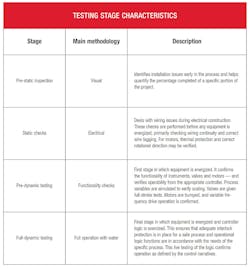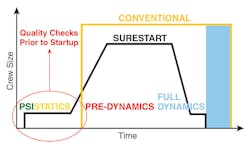As a project moves into its final phases, everybody’s interest is piqued. Individuals who may only have been involved at a distance often appear to share in the success but sometimes, instead, find disappointment. Production planned to start today gets pushed to tomorrow, next week, next month or worse. Why?
The final phases of a project are when problems, many of which existed all along, become most visible. Though a few people might have known issues existed, they expected all would be worked out eventually. Meanwhile, other problems seem to come out of nowhere. In either case, all problems must be fixed, and they come to light closer to the production startup deadline. Questions emerge at this stage: How did we get to this point? Can we do anything about it this late in the game?
Not every project ends up this way. Some move directly and positively at every stage. They begin and end on time and on budget. Naturally, some problems pop up from time to time, but they are minor and can be fixed quickly. This article examines how to deal with difficult situations and, often more importantly, how to avoid them in the first place.
All about planning
A project launched without adequate planning has little chance of success. However, effective planning is only part of a great project. Success also depends on effective execution. How should these two tasks work together?
A plan is only as good as the people charged with developing it. Conscientious and well-meaning people might be excellent at their regular jobs, have the company’s best interests in mind and believe they are doing the right things only to find that their best efforts are inadequate. Often, they simply do not have the necessary qualifications to make a project a success.
An individual may be a well-qualified process engineer, control room operator or technician, but when handed the task of helping lay out the steps of a unit upgrade or automation system improvement, he or she could quickly be in deep water when taking on the role of a project manager. To make matters worse, the reality of the situation might not be recognized until it is too late.
The plan may seem to be complete when in reality it has serious gaps. Those carrying out the planning must be qualified and understand the specific requirements of the project. Simply bringing a collection of well-meaning, smart and experienced people into a planning meeting does not ensure success. Sometimes, despite the quality of the plan, if not executed well, it has little chance of success.
Execution: A critical element
Most projects begin to break down because critical events do not occur when they should. This may seem obvious, but the number of problem projects suggests that many people do not adequately understand this issue. Examples of execution breakdowns are:
- An electrical contractor wired the motor for a pump to move product from a reactor to the next process stage. Since the details related to the installation were not fully spelled out, the contractor considered the installation finished and moved on without interfacing the motor control center with the process automation system. When the motor was tested during commissioning, the operators had no way to activate it from the control room. The contractor’s crew had left the site, considering the project finished. The work then had to be done by someone else at additional expense, delaying the startup.
- Installers working on the piping between two vessels tried to mount a flowmeter at a critical point only to discover that the flange size was wrong. As the process details were being finalized, the pipe diameter was increased because of anticipated problems with the liquid velocity. Some of the related components were resized, but this equipment was overlooked. The flowmeter had to be returned, and a new unit ordered at the correct size, restarting the delivery time clock.
- Operators worked on startup and saw that the data from a device were erratic. Some quick troubleshooting suggested a bad cable termination. A technician was dispatched to ensure that the screws were tight but could not find the device. The technician had to find the equipment by reading tags one by one.
When incidents like this happen repeatedly, a schedule falls apart and gets pushed beyond the original startup date, causing additional costs to accumulate (see Figure 1). Most incidents are not disastrous if taken individually. However, as they accumulate, time and costs grow. Buying a new flowmeter or calling in another electrician are bad enough in terms of direct costs, but the greater cost comes from the lost revenue from a delayed startup.
What makes a project run well?
The best insurance of a good outcome is effective planning and execution. And “effective” in this context means plans created by people who understand how these projects work and how to execute them well. These plans must include the detail necessary to avoid the problems that routinely occur during construction, commissioning and startup. The plan then must be executed effectively by people who know what they are doing.
While it is ideal to plan well from the start, consider, instead, a project that is far into its schedule but did not have the kind of planning it should have. Is it doomed to failure? It does not have to be. However, as a practical matter, everything hinges on how deep the problems are. Any project can be salvaged to some extent, no matter how far off the rails it is, but the solution may be difficult to implement.
Recognizing developing problems
Companies generally realize they are in trouble when a project gets into the early execution phases such as during factory acceptance testing. By this point, construction has been going on for a while, and some problems have emerged because of incorrect specifications or ineffective scheduling. The main automation platform has also been under design, and it has reached the point at which the customer’s team needs to begin evaluating its capabilities to ensure it will perform as needed.
Automation system problems also emerge at this point. The automation original equipment manufacturer (OEM) builds it according to the requirements provided by the customer, so it will only be as good as those requirements. A poorly planned system will create a poor result, and the OEM cannot make up for inadequate specifications. The critical turning point hinges on whether anyone recognizes the problems at this point. People evaluating the system based on the requirements probably have no way of knowing they are not adequate for the application, and they might simply accept the system because it meets specifications. After installation and commissioning begins, inadequacies emerge.
As problems compound, companies often realize they are in over their heads. This is the point at which some begin to consider calling for outside help.
Back on track
The first step to getting a project back on track is realizing construction can, and must be, actively managed. Many companies see construction as a black box – it has a start and an end, but what goes on in between is a mystery. Getting a project completed on time and on budget involves taking the bull by the horns and making it work. This is not an easy task and not for the faint-hearted, but it is absolutely necessary.
The construction time line needs to be broken into subsections so it can be managed and tested along the way. This includes pouring concrete, fabricating support structures, pulling wires and pipe fitting. Good construction managers recognize which steps can run simultaneously, helping to collapse the schedule rather than seeing everything as a series of separate events in a long chain.
As activity progresses, everything must be tested upon completion. No step should be considered finished until functionality has been verified. Too often, companies think of testing as an independent stage in which all sorts of elements are checked simultaneously late in the project.
While this may seem logical, it causes issues to be discovered later in the process than they should have been and compounds the problem. The person or company responsible for the work has probably already left the site. Obviously getting someone to return under those circumstances is challenging enough, but even if the responsible party is conscientious and helpful, it will cause delays at a critical time.
Individual contractors, regardless of where they fall in the schedule, must have their work tested and approved while still on-site. They will also be held accountable for correcting any problems they cause and fixing items left undone. These will not be added-cost items if they are caused by contractor error.
Three stages of early testing
To be effective, testing has to follow procedures appropriate to the equipment or system being evaluated. In the time before the actual commissioning stage begins, three testing phases (see Table 1) are available:
- Pre-static inspection – During this phase, installation issues are looked for. It needs to be carried out as early as possible following the installation of a component. This is largely a visual process, checking to see if components are bolted in correctly or mounted in the right position among other items. The project manager must keep parallel activity moving to avoid schedule slippage. Successful tests are identified in overall plant diagrams or via an electronic tracking tool.
- Static checks – Aimed at electrical equipment, this phase verifies wiring before anything is energized. Again, it is largely visual, checking components including continuity, wire tagging, proper thermal protection and proper motor rotation. These tests are crucial to verifying a contractor’s performance and percentage of completion.
- Pre-dynamic testing – At this step, equipment is energized for the first time, and most lurking problems surface. These tests confirm the functionality of the instruments, valves and motors, verifying operability from the appropriate controller. Process variables may be simulated to verify scaling. Valves are given full-stroke tests. Motors are bumped, and variable frequency drive operation is confirmed.
Obviously these are issues that should be resolved before commissioning begins. Correcting motor rotation or a valve’s ability to communicate with the distributed control system needs to happen at this point, rather than later.
Even if a project does not start out well, bringing in effective management early in the execution phase can help get it back under control. The testing process can expose many problems so they can be fixed, provided the people doing the testing are experienced enough to spot problems and know how to address them. Any changes should be documented, preferably using an electronic tracking platform that records completed work in the larger picture and in real time.
Commissioning
At this point, most things should be ready to go. Commissioning begins with full dynamic testing in which equipment is energized. Control logic is exercised to ensure adequate interlock protection is in place. Operational logic functions are tested in accordance with the needs of the process. Parts of the control programming might need to be reworked, and this is the time to make and document those changes to avoid any production delays.
Electronic documentation and record keeping avoids the time required for conventional loop sheets and sign-offs. Since data can be entered in real time, project engineers and managers know the project’s status. Keeping things moving quickly and positively while managing the number of people on a site requires individuals with critical skills (see Figure 2). Technicians experienced in project startups are not easy to find, so having enough to keep a project on target could require working with a specialized partner.
Starting production
The movement into actual production is a critical time, but if everything has worked well during commissioning, the team should experience few surprises. Some aspects of the process may need finetuning, but a well-designed unit should not require extensive reworking.
Much is required to get the automation system closed out and fully documented. Traditional methods for handling this are tedious and subject to errors. Electronic solutions are faster and avoid manual operations.
Simple actions, such as mounting QR codes on field devices (see Image 1), can help operators and technicians access information about a device in seconds. They can even use GPS location to tell a technician exactly where a specific tag-numbered component is. Guesswork and manual operations can be reduced significantly or eliminated altogether.
Keys to an effective project
A successful project – finished on time and within its original budget – produces the outcomes originally hoped for by the participants and other stakeholders. Making this happen requires a combination of tools and techniques driven by people who know how to make them work. While many new technologies can simplify record keeping and information retrieval, management is still largely a human skill. Experience is a critical component, which is why engaging the right partner goes a long way toward ensuring success.
Joel Boisselle is the director of consulting and field operations for MAVERICK Technologies in Columbia, Illinois. He may be reached at [email protected].







